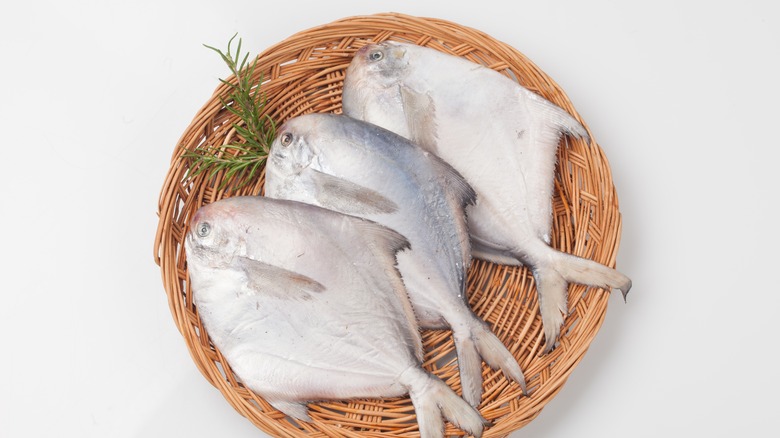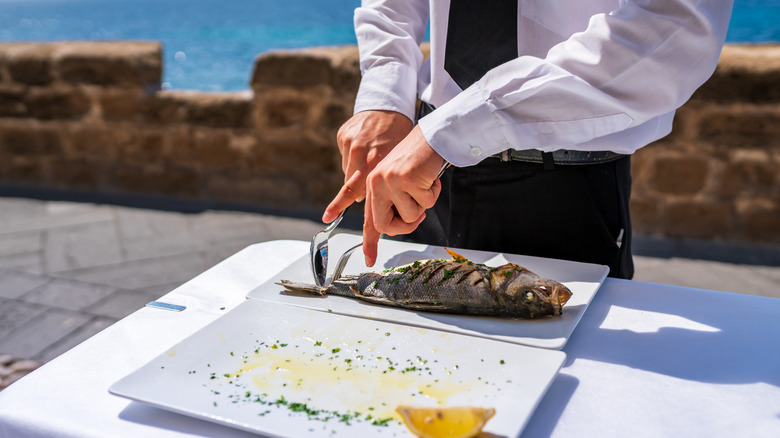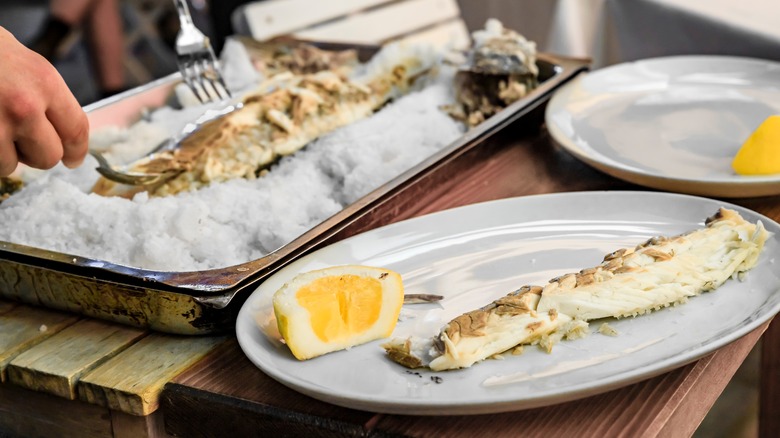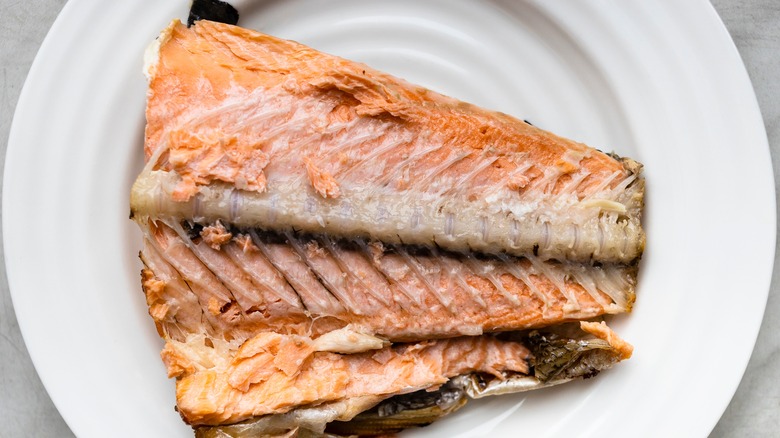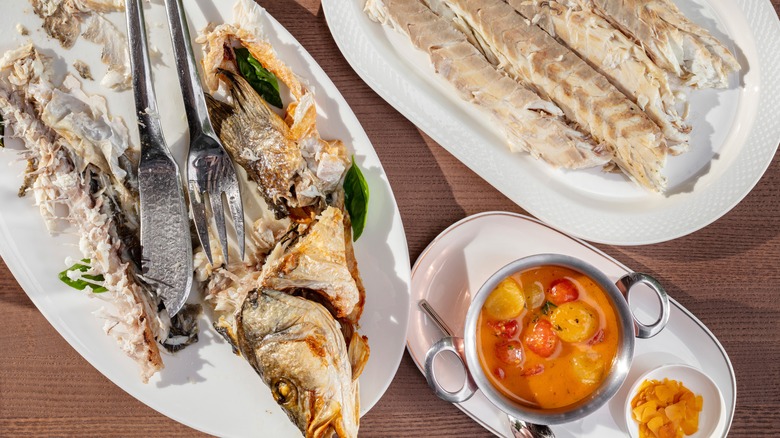How To Eat A Whole Fish And Look Like A Pro Doing It
Even for seasoned seafood lovers, the thought of taking on a whole fish at the dinner table can be overwhelming. With eyes staring up at you from the plate and the skin, fins, and a whole collection of bones standing between you and your meal, the logistics alone are enough to make you rethink your order. Things become even more complicated when you factor in appropriate table manners.
Despite this, enjoying a whole fish is well worth it, as cooking it in intact produces much more flavorful, juicy meat. That's why whole fish cooking is such a popular practice across countless global cuisines. Whether you're served a whole branzino at a Mediterranean spot or have the chance to try Chinese-style whole fish, which has become a tradition for Lunar New Year, the easiest way to eat is about the same — though etiquette can change from one culture to the next.
It may take a bit of practice before you're able to carve a whole fish confidently, but the steps aren't as hard to navigate as you might think. Once you know the right order for the whole process, and how to most efficiently execute each part, you'll surprise yourself with how easily you can tackle this initially intimidating task.
Get to know your fish
The first thing you want to figure out is whether you're dealing with a round fish — such as salmon, cod, bass, and trout — or a flat fish, like sole, halibut, or flounder. The skeletons in these two types of fish are different, and each requires a different approach when carving.
Round fish are what you are most likely to imagine when you envision the animal. They move with their bodies in a vertical position, have an eye on either side of their heads, and swim by moving their tails from left to right. Because of their body shape and movement, they have a spine that runs from head to tail, ribs that curve down from the spine on either side, and clusters of bones to facilitate fin movement at their back, tail, and either side.
Flat fish, on the other hand, are carnivorous bottom dwellers. To accommodate this lifestyle, their bodies are flat, both eyes are on one side of their body, and they swim in a horizontal position along the sea floor. Fins run from their head to tail on either side, meaning that there are floating bones that span their whole perimeter. Knowing which group your meal falls into will help you understand the best way to go about removing the flesh. It will also help you know where you can expect to find bones, which hopefully eliminates unnecessary choking hazards.
Remove the head, tail, and fin bones
Using a fork and knife, remove the head, tail, and fin bones of the fish and set them aside on a discard plate. The first two will come off easily enough — though a bit of force may be needed to sever the spinal connection — but the fins can be a bit trickier. Fin bones aren't connected to the central skeleton, so they are harder to find. If you're eating a flat fish, the fin bones that run along either side may have been removed before cooking. Even if they have, be aware that you'll likely still encounter some as you work to debone the fish for eating.
Depending on the type of round fish you're eating, the number of fins found along the spine and near the belly will vary, but expect between four and five. Once cooked, you'll be able to insert your fork at the base of each fin and essentially pull the whole fin out, bones and all. Be mindful as you eat that a bone or two may have been left behind after this process. It's always better to be prepared to remove a bone from your mouth, rather than swallowing one.
Identify the lateral line and remove the meat
Imagine a line running horizontally down the middle of your plated fish, from nose to tail. If you peek below the skin in this region, you'll actually be able to see a delineation in the flesh here. This is called the lateral line, a biological feature of fish that allows them to perceive hydrodynamic shifts in their surroundings. In terms of carving a fish, whether flat or round, this is the point from which we work to remove meat.
Technically, flat fish have four fillets — one on either side of the lateral line, on both their upper and lower sides — and round fish only have one fillet on either side of their bodies. But when sitting down to eat a whole fish, it's easiest and most efficient to extract everything above the lateral line, and then below, as two separate sections.
You can choose to remove the fish's skin first, or carve the lateral line through the skin and remove the meat with the skin still attached. In either case, insert your fork at the lateral line and use it to easily push the meat up or down, removing it from the body in large pieces that can be set aside or moved to a serving dish. The flesh of flat fish is a bit more reluctant to come off, and you may need to insert a utensil underneath the fillet to remove it from the bones.
Remove the skeleton
Once the uppermost layer of meat has been removed, the fish's central skeleton will be exposed. Again, if your fish is properly cooked, these bones can be pulled out easily. Simply tuck the tines of your fork under the larger bones of the spine and pull up slowly, moving gradually from one end of the fish to the other until the central skeleton is separated from the body. Set this on your discard plate and get to work on the lower fillets next.
Debone lower fillets and enjoy
Now that the skeleton has been removed, examine the lower portion of your fish to see if any large bones have been left behind from the spine. Then, take a moment to give special attention to where the fish's fins were placed. Since these bones are a bit more tucked away than those in the spinal column, you want to ensure nothing is left behind that could pose a hazard down the road.
Once you're confident that no bones remain, you're ready to plate up the meat and enjoy!
Etiquette for eating whole fish at a restaurant
When dining on whole fish in the company of others, keep the process as neat as possible and try to avoid using your hands. Take your time carving out fillets with a fork and knife, do your best to ensure you're removing skin and bones, and only use your fingers when necessary. If a bone does wind up in your mouth, do your best to clean any meat off of it, then discretely remove it from your mouth with your fingers. While spitting things into your hand isn't ideal, it's better than drawing attention to your misstep (and endangering yourself) through coughing or even choking.
Another important note is that, in most situations, you want to avoid flipping your fish over. While it may feel like a shortcut that allows you to avoid extracting the skeleton at the table, it can be a messy move that's looked down upon in most settings. It's full-on bad etiquette to flip a whole fish in Chinese dining, for instance. Whenever possible, do your best to work top-down in any dining situation, to avoid offending your company.


